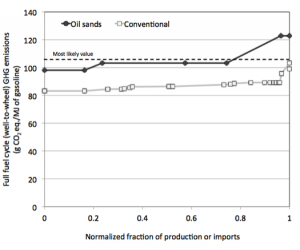Imagine you're a toy manufacturer, shipping your product overseas. One of your customers tells you that they're reducing the amount of lead in their toys and studies show that your products are among the worst. They ask that you reduce the toxic content of your product or they'll stop buying it.
What do you do? You can call the production manager and fix the problem, or complain to your customer about the quality of your competitors' products. As cunning as the latter option may seem, this is how Canada is currently reacting to proposed European rules to reduce greenhouse gas pollution from transportation fuel production.
This week I'm in Brussels with colleagues to discuss the merits of Europe's Fuel Quality Directive (FQD), and its assignment of a greenhouse gas pollution value on oilsands bitumen. The FQD is part of the European Union's commitment to a 20 per cent reduction in carbon emissions by 2020, and to help fulfill this goal, suppliers of transport fuels are obliged to reduce the lifecycle GHG intensity of their products — gasoline, diesel, and jet fuel - by six per cent by 2020 relative to 2010.
To achieve this, the EU Commission proposes that each major fuel "feedstock" entering Europe be assigned a value for its carbon intensity, based on its lifecycle emissions from production through to end-use combustion.
While Canada and Alberta are lobbying against the recent EU Commission decision to assign a specific value for bitumen, sending federal Natural Resources Minister Joe Oliver to Paris and London last week to persuade the EU to rethink the directive, we think that Europe should stand firm, for the following reasons:
Oilsands shouldn't be given a free pass.
 Concerns that the FQD is unfairly discriminating Canadian oil are unfounded. The proposed value for bitumen isn't based on geographical location, but rather on its feedstock. This means transportation fuels that are produced from different types of feedstock are categorized separately. For example, biofuel produced from sugar cane gets a separate value from biofuel produced from wheat. Similarly, fuels produced from shale oil and fuels produced from natural bitumen are in a different category from conventional oil. This is a logical first step to take when looking at different carbon intensities of fuel.
Concerns that the FQD is unfairly discriminating Canadian oil are unfounded. The proposed value for bitumen isn't based on geographical location, but rather on its feedstock. This means transportation fuels that are produced from different types of feedstock are categorized separately. For example, biofuel produced from sugar cane gets a separate value from biofuel produced from wheat. Similarly, fuels produced from shale oil and fuels produced from natural bitumen are in a different category from conventional oil. This is a logical first step to take when looking at different carbon intensities of fuel.
Minister Oliver has recently argued that the FQD, "actually penalizes countries and companies that provide transparent, independently verifiable data." However, rather than defending the oilsands industry and the Government of Canada from market pressures for low-emissions fuel, Oliver should be advocating that the FQD require transparency and GHG accounting at the outset, raising the bar for all countries that export fuel to Europe.
While the vast majority of commercial oilsands development is currently happening in Alberta, with current production at approximately 1.6 million barrels per day, other reserves exist globally in countries such as Venezuela, Madagascar, the Republic of Congo, the United States and the Russian Federation. Some of these resources are currently being considered for development and would get the same default value placed on the fuel they produce.
The FQD rewards oilsands producers that reduce the GHG emissions of their product.
Some commentators have argued that the FQD will penalize oilsands producers that do clean up their GHG emissions and come in below the average. This is not true. In fact, oilsands producers that have a GHG emission intensity lower than the FQD's default value can receive their own value by reporting their actual emissions.
More and more oilsands operators believe that they can get their oilsands production emissions down to a level competitive with conventional oil. This has yet to be demonstrated, but if it is true, why then, are the Canadian government and oilsands companies lobbying so hard against a directive that allows them to prove that they can compete in a low-carbon future?
The proposed target for bitumen is based on good science not speculation.
 The oilsands are a high carbon source of energy and independent analysis shows that even the cleanest oilsands fuel is dirtier than 98 per cent of conventional oil entering Europe. The value of 107g CO2/MJ stems from a peer reviewed study from Stanford University that was commissioned by the EU to provide a comprehensive analysis of the GHG intensity of crudes entering Europe. The study found that the most likely, or "average," value for oilsands is 23 per cent more GHG intensive than the average for conventional crude imported into the EU.
The oilsands are a high carbon source of energy and independent analysis shows that even the cleanest oilsands fuel is dirtier than 98 per cent of conventional oil entering Europe. The value of 107g CO2/MJ stems from a peer reviewed study from Stanford University that was commissioned by the EU to provide a comprehensive analysis of the GHG intensity of crudes entering Europe. The study found that the most likely, or "average," value for oilsands is 23 per cent more GHG intensive than the average for conventional crude imported into the EU.
In short, Natural Resources Minister, Joe Oliver's comment that, "there has not been a comprehensive scientific study of the greenhouse gas (GHG) intensity of crude oils currently used in the European Union," is plain wrong.
Our conclusion
Given Canada's inaction on addressing GHG pollution — including our failure to meet our Kyoto commitments, our current trajectory heading toward failure to meet our modest commitments in Copenhagen, and Canada's continued apparent inability to regulate its own GHG emissions — we're hardly in a position to lecture Europe about its GHG policies.
The proposed values for bitumen in the EU's FQD send a signal to fuel suppliers that the marketplace is now considering the carbon intensity of various fuels. Instead of lobbying European countries and downplaying the significance of GHGs from the oilsands, Canadian decision makers could do better by implementing regulations to drive down emissions from the oilsands sector so that it can comply with the FQD's new proposed rules.
After all, had our federal government acted swiftly to regulate oilsands emissions almost two decades ago, its fuel might be meeting customer demand for low carbon products today, rather than being a target for criticism.






